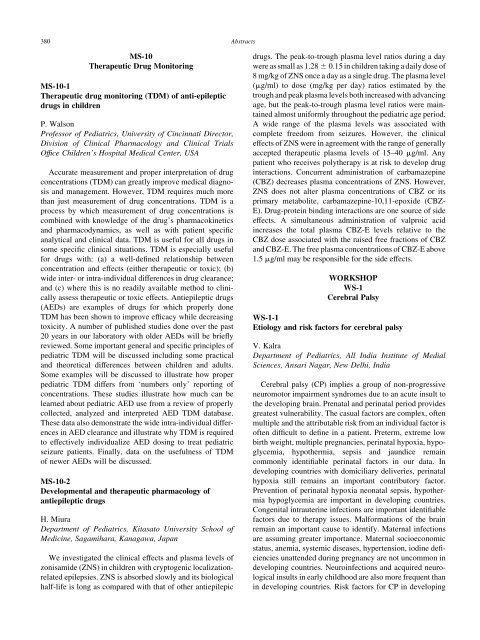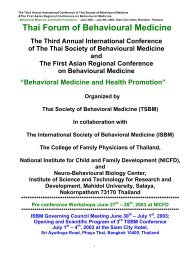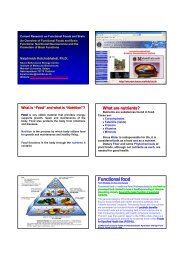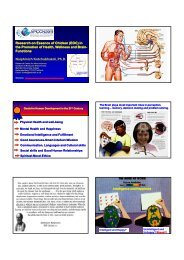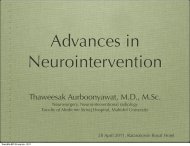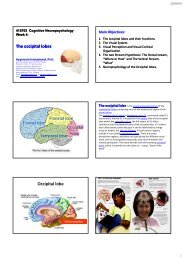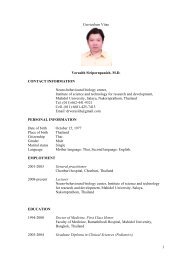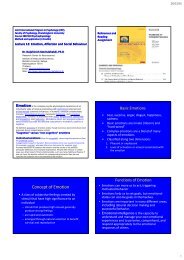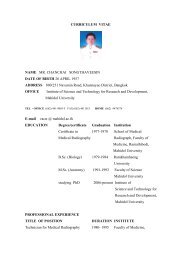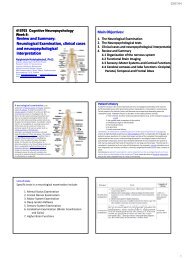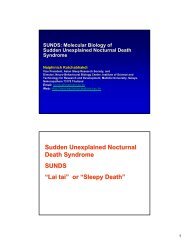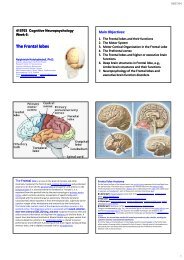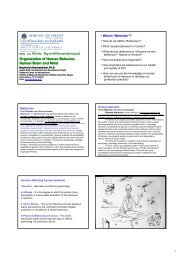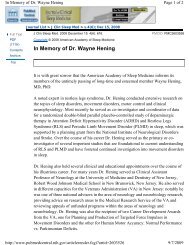PDF File - Mahidol University
PDF File - Mahidol University
PDF File - Mahidol University
You also want an ePaper? Increase the reach of your titles
YUMPU automatically turns print PDFs into web optimized ePapers that Google loves.
380<br />
Abstracts<br />
MS-10<br />
Therapeutic Drug Monitoring<br />
MS-10-1<br />
Therapeutic drug monitoring (TDM) of anti-epileptic<br />
drugs in children<br />
P. Walson<br />
Professor of Pediatrics, <strong>University</strong> of Cincinnati Director,<br />
Division of Clinical Pharmacology and Clinical Trials<br />
Office Children’s Hospital Medical Center, USA<br />
Accurate measurement and proper interpretation of drug<br />
concentrations (TDM) can greatly improve medical diagnosis<br />
and management. However, TDM requires much more<br />
than just measurement of drug concentrations. TDM is a<br />
process by which measurement of drug concentrations is<br />
combined with knowledge of the drug’s pharmacokinetics<br />
and pharmacodynamics, as well as with patient specific<br />
analytical and clinical data. TDM is useful for all drugs in<br />
some specific clinical situations. TDM is especially useful<br />
for drugs with: (a) a well-defined relationship between<br />
concentration and effects (either therapeutic or toxic); (b)<br />
wide inter- or intra-individual differences in drug clearance;<br />
and (c) where this is no readily available method to clinically<br />
assess therapeutic or toxic effects. Antiepileptic drugs<br />
(AEDs) are examples of drugs for which properly done<br />
TDM has been shown to improve efficacy while decreasing<br />
toxicity. A number of published studies done over the past<br />
20 years in our laboratory with older AEDs will be briefly<br />
reviewed. Some important general and specific principles of<br />
pediatric TDM will be discussed including some practical<br />
and theoretical differences between children and adults.<br />
Some examples will be discussed to illustrate how proper<br />
pediatric TDM differs from ‘numbers only’ reporting of<br />
concentrations. These studies illustrate how much can be<br />
learned about pediatric AED use from a review of properly<br />
collected, analyzed and interpreted AED TDM database.<br />
These data also demonstrate the wide intra-individual differences<br />
in AED clearance and illustrate why TDM is required<br />
to effectively individualize AED dosing to treat pediatric<br />
seizure patients. Finally, data on the usefulness of TDM<br />
of newer AEDs will be discussed.<br />
MS-10-2<br />
Developmental and therapeutic pharmacology of<br />
antiepileptic drugs<br />
H. Miura<br />
Department of Pediatrics, Kitasato <strong>University</strong> School of<br />
Medicine, Sagamihara, Kanagawa, Japan<br />
We investigated the clinical effects and plasma levels of<br />
zonisamide (ZNS) in children with cryptogenic localizationrelated<br />
epilepsies. ZNS is absorbed slowly and its biological<br />
half-life is long as compared with that of other antiepilepic<br />
drugs. The peak-to-trough plasma level ratios during a day<br />
were as small as 1.28 ^ 0.15 in children taking a daily dose of<br />
8 mg/kg of ZNS once a day as a single drug. The plasma level<br />
(mg/ml) to dose (mg/kg per day) ratios estimated by the<br />
trough and peak plasma levels both increased with advancing<br />
age, but the peak-to-trough plasma level ratios were maintained<br />
almost uniformly throughout the pediatric age period.<br />
A wide range of the plasma levels was associated with<br />
complete freedom from seizures. However, the clinical<br />
effects of ZNS were in agreement with the range of generally<br />
accepted therapeutic plasma levels of 15–40 mg/ml. Any<br />
patient who receives polytherapy is at risk to develop drug<br />
interactions. Concurrent administration of carbamazepine<br />
(CBZ) decreases plasma concentrations of ZNS. However,<br />
ZNS does not alter plasma concentrations of CBZ or its<br />
primary metabolite, carbamazepine-10,11-epoxide (CBZ-<br />
E). Drug-protein binding interactions are one source of side<br />
effects. A simultaneous administration of valproic acid<br />
increases the total plasma CBZ-E levels relative to the<br />
CBZ dose associated with the raised free fractions of CBZ<br />
and CBZ-E. The free plasma concentrations of CBZ-E above<br />
1.5 mg/ml may be responsible for the side effects.<br />
WORKSHOP<br />
WS-1<br />
Cerebral Palsy<br />
WS-1-1<br />
Etiology and risk factors for cerebral palsy<br />
V. Kalra<br />
Department of Pediatrics, All India Institute of Medial<br />
Sciences, Ansari Nagar, New Delhi, India<br />
Cerebral palsy (CP) implies a group of non-progressive<br />
neuromotor impairment syndromes due to an acute insult to<br />
the developing brain. Prenatal and perinatal period provides<br />
greatest vulnerability. The casual factors are complex, often<br />
multiple and the attributable risk from an individual factor is<br />
often difficult to define in a patient. Preterm, extreme low<br />
birth weight, multiple pregnancies, perinatal hypoxia, hypoglycemia,<br />
hypothermia, sepsis and jaundice remain<br />
commonly identifiable perinatal factors in our data. In<br />
developing countries with domiciliary deliveries, perinatal<br />
hypoxia still remains an important contributory factor.<br />
Prevention of perinatal hypoxia neonatal sepsis, hypothermia<br />
hypoglycemia are important in developing countries.<br />
Congenital intrauterine infections are important identifiable<br />
factors due to therapy issues. Malformations of the brain<br />
remain an important cause to identify. Maternal infections<br />
are assuming greater importance. Maternal socioeconomic<br />
status, anemia, systemic diseases, hypertension, iodine deficiencies<br />
unattended during pregnancy are not uncommon in<br />
developing countries. Neuroinfections and acquired neurological<br />
insults in early childhood are also more frequent than<br />
in developing countries. Risk factors for CP in developing


